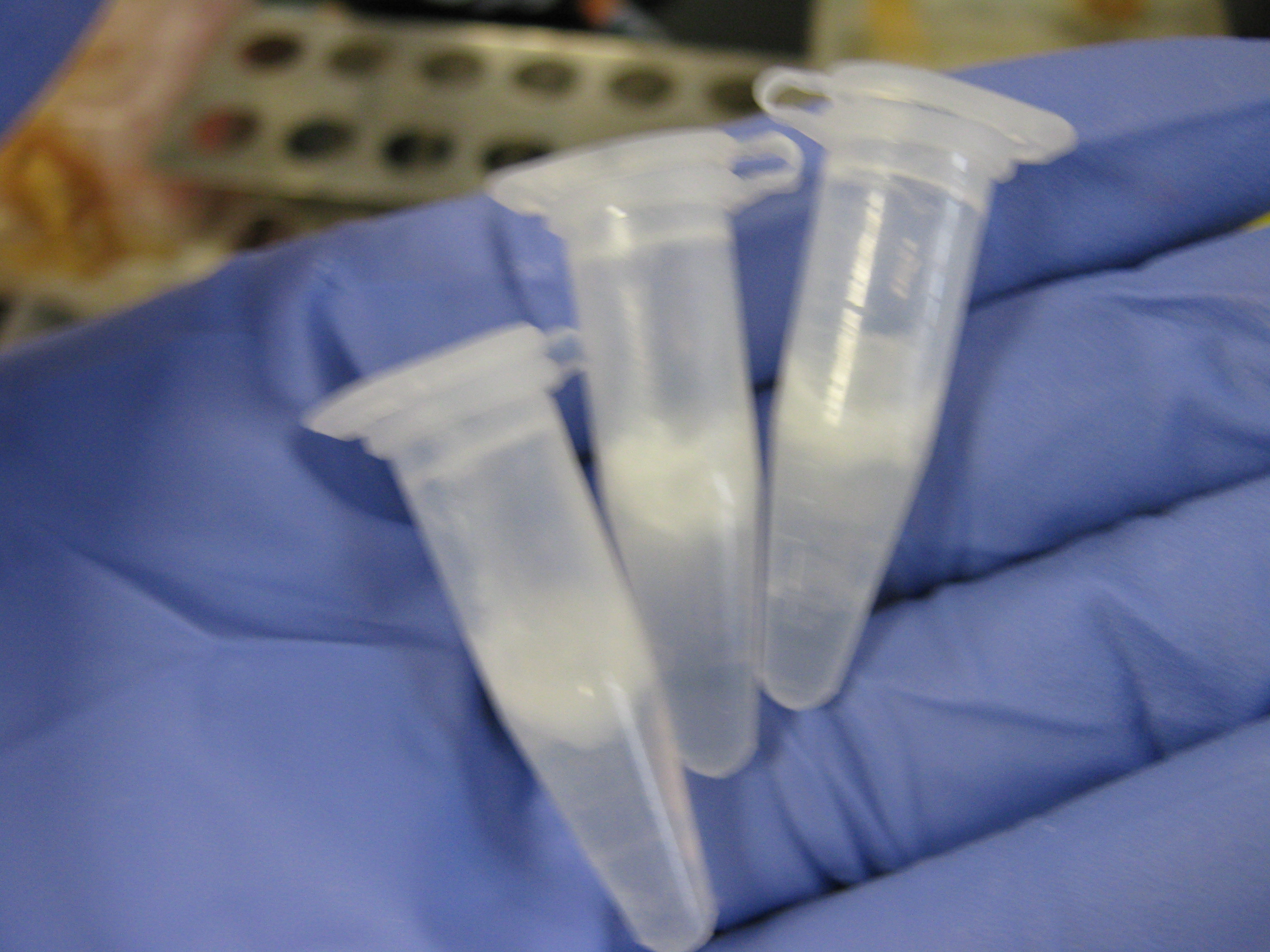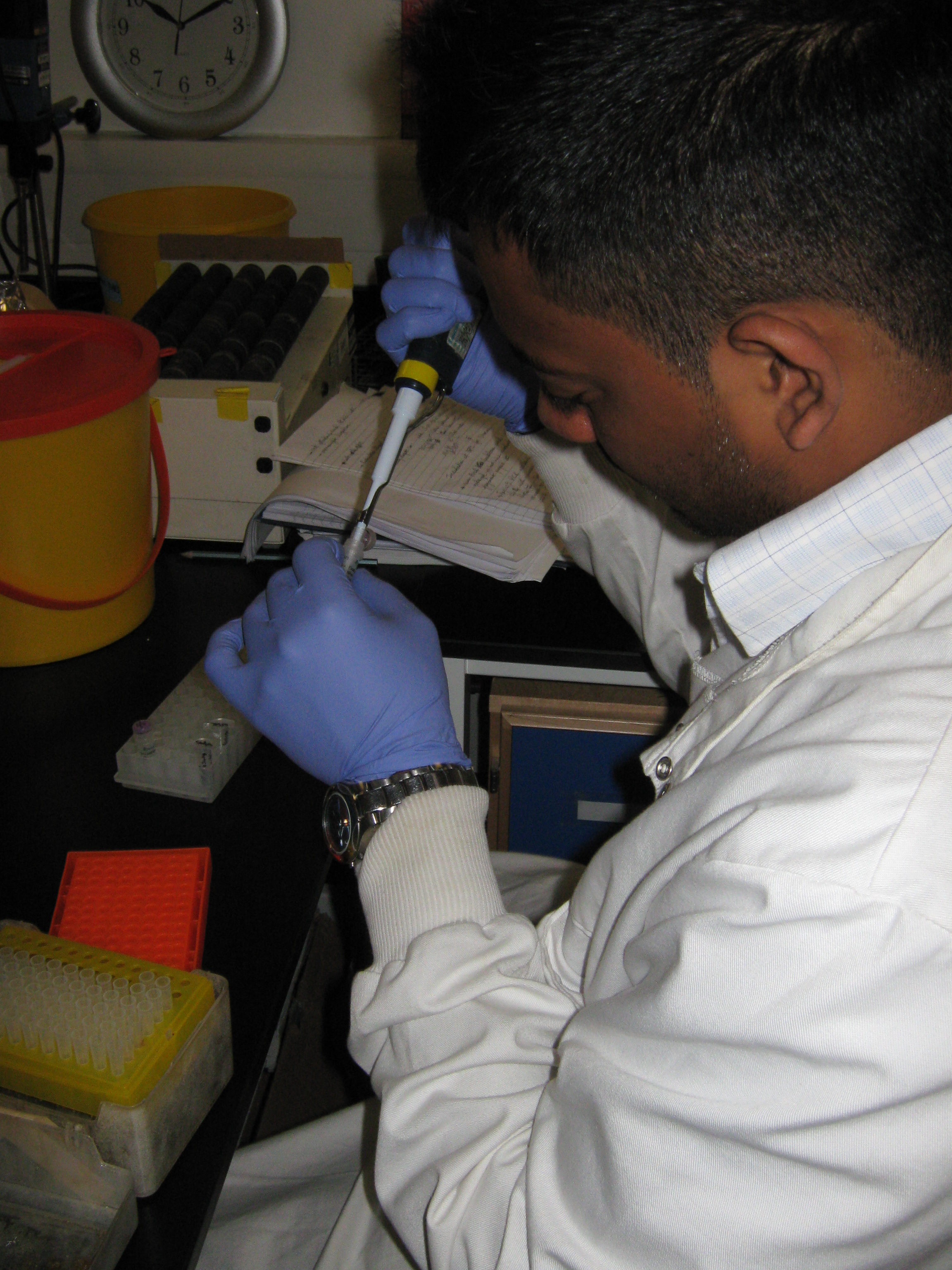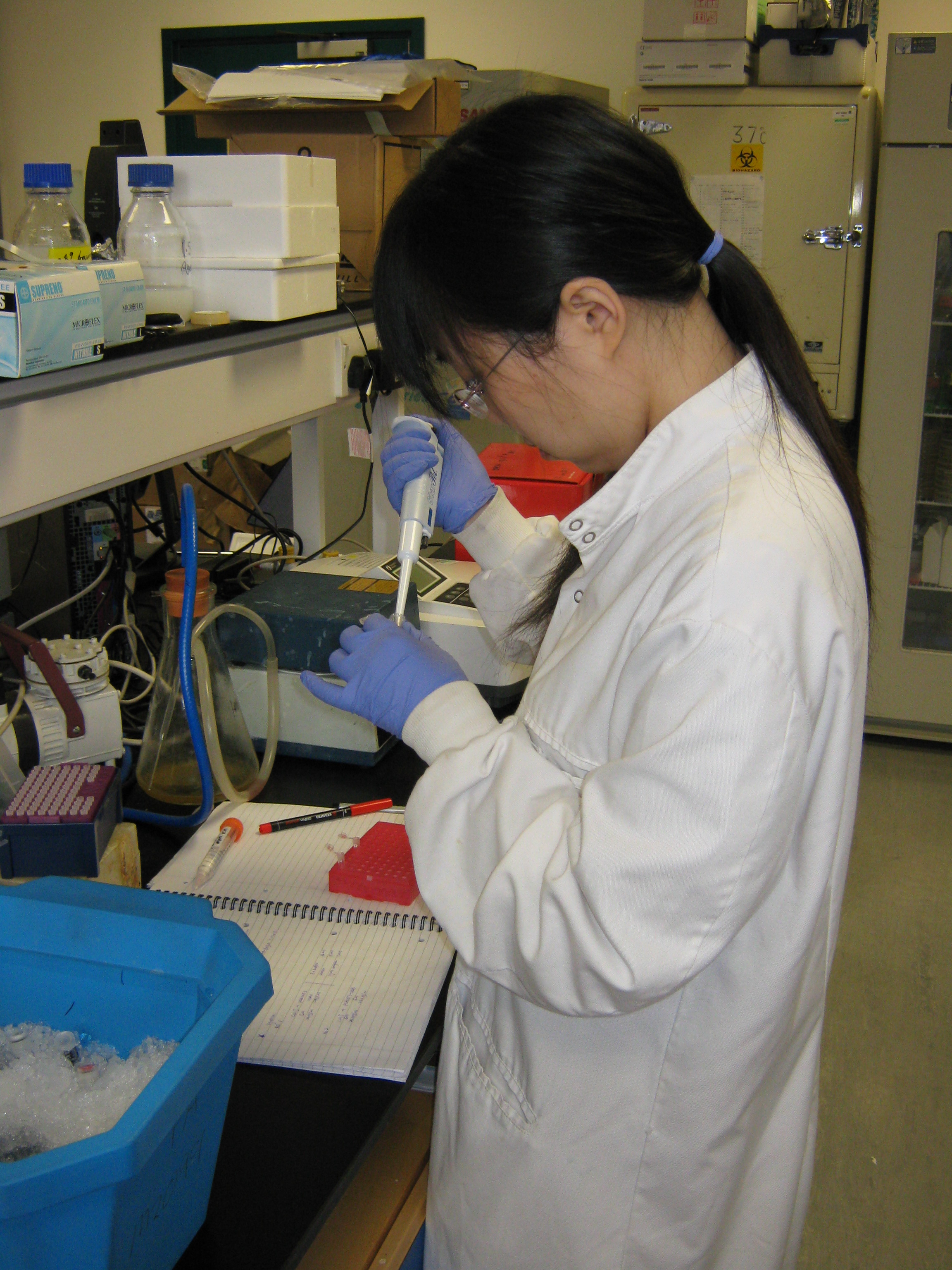Team:Newcastle/Labwork/16 September 2009
From 2009.igem.org
Formal Lab Session - 16th September 2009
Overview
Stochastic Switch Team
Today we ran the ara PCRs from yesterday on a gel and got a really good result, this product was then cleaned, cut with EcoRI and SpeI, cleaned again, then ligated with the pre-cut pSB1AT3 plasmid backbone.
Today we also did minipreps of 12 each of the sac and ara cultures... however unfortunately today the centrifuge we had been relying on broke, and therefore all three teams were forced to use one small centrifuge. This meant that the minipreps could end up being of poor quality due to waiting times for the centrifuge.
Metal Sensor Team
Introduction
In the last lab session, the Metal Sensing picked 12 colonies from a plate containing E. coli + cotC-GFP-smtA transformants and used them to inoculate 12 tubes containing LB + ampicillin - these wil be used for mini-preps today. In yesterday's session we also discovered that the attempts to transform E. coli with the arsR-cadA cadmium sensor failed, so on that same day we carried out a second attempt at transforming E. coli with this BioBrick.
Today's lab session will be focussed on carrying out the mini-preps for the 12 colonies of potential E. coli + cotC-GFP-smtA transformants and based on analysis, will determine whether midi-preps will follow or whether we need to reattempt another transformation (we would, of course, have to carry out another ligation reaction of the cotC BioBrick and the pMUTIN4 plasmid first)
To prepare for the eventuality that the ligations, transformations and midi-preps of the cotC-GFP-smtA in pMUTIN4 worked, the "Evening before transformations day" steps of the Bacillus subtilis transformation protocol will be carried out too.
The plate containing the cadmium-sensor E. coli transformants will also be studied - if there are colonies, 12 of them will be prepared for mini-preps; if there is no success then ligation of the BBa_J33206 BioBrick (promoter removed) with the cadA promoter will be carried out - E. coli cells will then be transformed with this.
Practical Outline
- Carry out mini-preps on the 12 colonies of potential E. coli + cotC-GFP-smtA (in pMUTIN4) transformants
- Digest these mini-preps with BamHI and HindIII'
- Analyse the mini-prep digests by DNA gel electrophoresis
- If there are any successes, prepare midi-prep cultures from leftover overnight incubations
- If no colonies present the desired DNA then conduct another ligation of cotC with pMUTIN4 and transform E. coli with this ligated product.
- Carry out the "Evening before transformations" step in the Bacillus subtilis transformation protocol.
- If there are arsR + cadA promoter (cadmium sensor) transformants on LB + ampicillin plate then prepare mini-preps from cultures. If unsuccessful:
- Digest the arsR backbone (BBa_J33206 without promoter) and the cadA promoter with BamHI and NheI
- Carry out overnight ligation reaction
Observations
The only observation that needs to be made now is: there are no colonies on the LB + ampicillin plates where competent E. coli cells, which we had attempted to transform with the BBa_J33206 BioBrick (which contains the arsR binding site and arsR gene) ligated to cadA promoter, were plated. This could be down to three things:
- The ligation between the BBa_J33206 BioBrick (minus promoter) and the cadA promoter didn't work.
- The transformation reaction didn't work
- Both the ligations and the transformations didn't work
Procedure
1) Processing the cotC-GFP-smtA in pMUTIN4 E. coli transformants
a) Mini-preps of cotC-GFP-smtA E. coli transformants
The mini-preps of the 12 colonies of E. coli cells (which are potentially cotC-GFP-smtA transformants) were carried out using Sigma-Aldrich's GenElute HP Plasmid Mini-prep kit with it's attached protocol. There were no changes to the protocol and the resulting plasmid DNA was placed in the -20ºC freezer.
b) Digesting and analysing the mini-preps
The 12 mini-prep samples were digested using BamHI and HindIII restriction enzymes. The digests were allowed to happen for 1 hour under 37ºC incubation (using the water bath). The contents of the 12 Eppendorf tubes were as follows:
- 10ul DNA
- 1ul of FastDigest BamHI restriction enzyme
- 1ul of FastDigest HindIII restriction enzyme
- 2ul of 10x FastDigest restriction buffer
- 6ul of sterile distilled water
The 12 digests were then analysed by DNA gel electrophoresis to yield the GelDoc photograph below.
This gel shows an unusual result - it appears that there is a huge amount of plasmid backbone DNA and only a very small amount of insert DNA. Whatsmore, the two bands don't even match the sizes predicted by information supplied for both pMUTIN4 and cotC-GFP-smtA. The band produced by the backbone fragment is roughly 4360 bp whereas it should be roughly 8,600bp; additionally the band produced by the insert fragment looks to be between 2027bp and 2322bp when cotC-GFP-smtA is actually 1385bp!
However most of the colonies picked seem to exhibit these band patterns which highlights consistency and means contamination is probably not a factor. It could be that the digests haven't worked properly.
c) Preparing midi-prep cultures
Based on the consistency of the bands exhibited by the 12 picked colonies of potential E. coli + cotC-GFP-smtA transformants, we took the decision to midi-prep culture sample 8 (hoping that the erroneous results were due to restriction enzyme error).
The mini-prep process only used 3ml of the 5ml LB (containing E. coli + cotC transformants) available so we could use 50ul of culture 8 LB + E. coli cells to inoculate 50ml of LB + antibiotic. This 50ml of LB (in a 100ml flask) was placed in the orbital incubator for overnight growth at 37ºC.
2) Second attempt at ligating together cadmium sensor
a) Digesting the BBa_J33206 backbone and cadA promoter
Because the attempts to transform E. coli with the ligated cadmium-sensor didn't work, the Metal Sensing team faced having to carry out the ligation again. The first step is to digest some more arsR backbone (BBa_J33206 without promoter) and cadA promoter with BamHI and NheI. The digests were allowed to run for 3 hours at 37ºC (regulated by water bath). The reactions were made up of the following:
- 20ul of DNA
- 5ul of 10x FastDigest buffer
- 1ul of FastDigest BamHI restriction enzyme
- 1ul of FastDigest NheI restriction enzyme
- 23ul of sterile distilled water
The digests were then cleaned up using Sigma-Aldrich's GenElute PCR clean-up kit with it's accompanying protocol; the resulting DNA was then stored in the -20C freezer.
b) Ligating the BBa_J33206 backbone with cadA promoter
Following the General Meeting on 16/09/09, it was decided that the production of the cadmium-sensor would be put on hold and more concentration will be placed on the cotC-GFP-smtA BioBrick. The cadmium-sensor is being synthesized and will arrive shortly anyway.
Sporulation Tuning/Chassis Team
Introduction
- Yesterday's transformation seems not work, so we need redo the ligation and transformation for cwlJ.
- Continue with yesterday's digestion, run the digested plasmid pSB1AT3:sleB in 0.8% agarose gel and cut the right band for gel extraction.
- Ligate cwlJ fragment with pSB1AT3:sleB backbone.
- Transform ligated pSB1AT3:sleB:cwlJ into E.coli.
Experiment procedure
Purify digested pSB1AT3:sleB
- Prepared 0.8% agarose gel.
- loaded digested plasmid in big well, 90v 30 -45 mins.
- Cut the right band und UV light.
- Purified backbone with Gel extraction Kit.
- After gel extraction, the volume of plasmid backbone is 90ul.
ligation and transformation
- L1: cwlJ + pSB1AT3
5 Fast ligation buffer 4ul
ddH2O 15ul
T4 ligase 1ul
cwlJ(24ng/ul) 10ul
pSB1AT3 backbone(12ng/ul) 10ul
--------------------------------------
total 40ul
- L2: cwlJ + pSB1AT3:sleB
5 Fast ligation buffer 4ul
ddH2O 15ul
T4 ligase 1ul
cwlJ(24ng/ul) 10ul
pSB1AT3:sleB backbone(24ng/ul) 5ul
--------------------------------------
total 35ul
- 37C incubator 1 hour.
- Follow the Phil's transformation protocal.
- Spray on LB+Amp+Tet plates for overnight grow.
Conclusion
- Concentration of cwlJ fragment(digested with EcoRI and speI) after gel extraction.
24.4ng/ul
- Concentration of pSB1AT3:sleB backBone(digested with EcoRI and XbaI) after gel extraction.
24.4ng/ul
Futher plan
- Mini and Midi Prep for cwlJ clone.
- Mini and Midi Prep for cwlJ and sleB double clone.
|
| |||||||||||||||||||||||||||||||||||||||||||||||||||||||||||||||||||||||||||||||||||||||||||||||||
|
| |||||||||||||||||||||||||||||||||||||||||||||||||||||||||||||||||||||||||||||||||||||||||||||
News
Events
- 20 – 21 June 2009 - Europe workshop (London)
- 23 – 24 June 2009 - UK iGEM meetup (Edinburgh)
- 23 October Practice Presentation (Newcastle)
- 23 October T-shirts are ready
- 27 October Practice Presentation (Sunderland)
- 27 October Poster is ready
- 30 October – 2 November 2009 - Jamboree (Boston)
Social Net
 "
"







